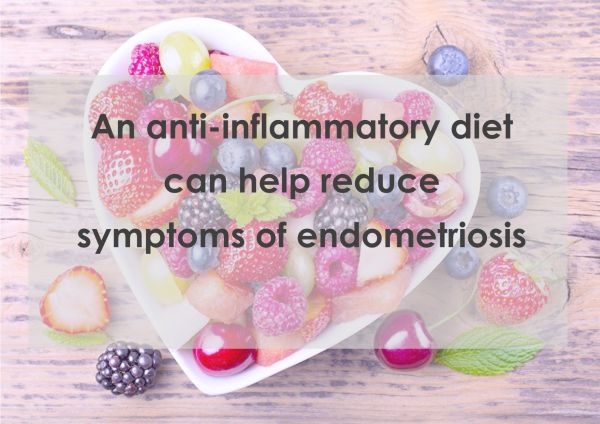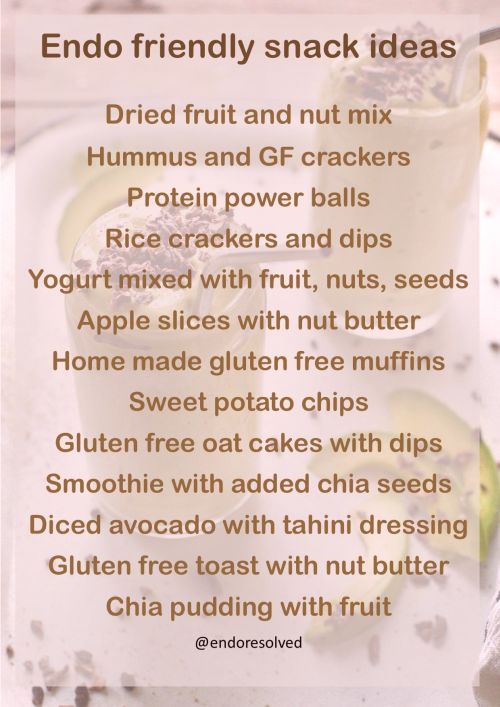Endo Diet - Quick start guide

Following an anti-inflammatory diet has many health benefits for your general health and can also help reduce the symptoms of endometriosis. An anti-inflammatory diet can help reduce bloating, reduce endo-belly as well as reduce pain. It will also help stabilise your blood sugars so that you are not getting those awful energy swings.
Some women feel overwhelmed when they read the details of the diet to help them with their symptoms and don’t know where to start, or feel that the diet is too restrictive. When you look at the list of the foods advised to leave out of your diet it looks like you will not be left with much to eat, but there are plenty of tasty, nutritious foods you can still enjoy.

'Before I changed my diet, life was one long round of pain meds, continuously going to the doctor with pretty regular trips to ER because of the intense pain. Well that's all in the past now and I can only say again, thank you so much.' - Cheryl, Arizon
The basis of the diet to help reduce the symptoms is based on the following:
- Reducing foods that cause inflammation
- Reducing foods the increase estrogens
- Reducing foods that cause bloating and endo belly
- Reduce foods that increase the negative prostaglandins which cause pain and inflammation
- Reducing foods that stress the body with chemicals and additives
- Adding in foods that help reduce inflammation
- Using foods the boost the immune system
- Ensuring you get a nutrient dense food intake
To give you a basic summary of the diet to help with the
symptoms of endometriosis:
Wheat - this includes breads, cakes and pasta products. Wheat contains phytic acid which can aggravate symptoms of endometriosis, which is an issue that has been covered by Dian Shepperson Mills in her book about nutrition for endometriosis. Wheat also contains gluten which women with endometriosis seem to be sensitive to and feedback from other endo sufferers who omitted wheat saw an improvement in their symptoms
Red meats - promotes the negative prostaglandins which cause inflammation and may also contain growth hormones which can include estrogen. There is a lot of debate as the whether red meat is an issue with endometriosis. For many women eating only grass fed beef does not cause an issue and increase their symptoms. However, I am doubtful if many with endo can afford to buy grass-fed beef in some countries, so you will have to use due diligence and maybe focus on white meats. Endometriosis affects every woman’s body differently and every woman will have different dietary triggers and restrictions
Refined and concentrated carbohydrates - white bread, flour, cakes, pasta etc. made from refined flours.. Refined carbs are bad because they lack fiber and nutrients and are quickly digested, causing blood sugar spikes that can lead to weight gain, insulin resistance,
Refined sugars - causes inflammatory reaction, produces a more acidic environment in the body which can increase the inflammation of endometriosis. Higher blood sugar causes higher estrogen production. So reducing sugar can make a difference in the symptoms of endometriosis
.Caffeine - found in tea, coffee, soft drinks - increases abdominal cramps and caffeine increases estrogen levels. Caffeine is a known phyto-estrogen. Coffee is also known to inhibit the absorption of iron. Too much caffeine creates inflammation in the body and aggravates the digestive system.
Chocolate (cheap commercial chocolate - as it contains sugar which is inflammatory) - organic dark chocolate is fine especially if it has high cacao content which has many health benefits
Dairy produce - including milk, cheese, cream - causes inflammatory reaction as they increase the inflammatory prostaglandins. Dairy products containing growth hormones and antibiotics can also worsen endometriosis symptoms. The jury is out regarding research as the whether dairy products are inflammatory and research results seem to be contradictory. Dairy products could promote inflammation due to the way they interact with the cells lining the gut and the byproducts they produce when broken down by the gut microbes.
Eggs - advised to leave out eggs unless you get organic as they may contain hormones. Organic eggs are more nutritious, often having higher levels of omega-3 fatty acids and vitamins A and E
Fried foods - can stimulate negative prostaglandins which will increase the amount of pain. Some studies suggest that the oxidized fats formed during frying can cause inflammation in the body.
Saturated fats and oils – Foods that are high in fatty acids stimulate the negative inflammatory prostaglandins. Fatty acids are found in saturated fats, butter, margarine, lard.
Soy products and soy protein products – soy has a negative effect on endometriosis as soy contains high levels of phytoestrogens - tamari can be used in small amounts. Soy also contains high levels of omega 6 which can cause inflammation. Read more about soy and endometriosis HERE
Convenience foods - they contain a host of additives, cheap ingredients and have very little nutritional value. They are often high in unhealthy fats, sugar, and salt, and low in essential nutrients and fiber. The additives, high fat, sugar, and salt content in many convenience foods can promote inflammation in the body. Some studies suggest that highly processed foods can alter the composition of gut flora, potentially contributing to negative health effects.
Canned/Tinned foods - use sparingly. Certain exceptions are fine like canned tomatoes and coconut milk. Most canned food has little nutrient value due to heating processes and many have added salt and sugars.
Additives and preservatives - increase chemical load on the system. Additives have hormonal disruption properties and certain additives can interfere with the endocrine system, which regulates hormones. Some emulsifiers and thickening agents may negatively alter gut microbiota, potentially exacerbating inflammatory bowel conditions. Certain additives may contribute to obesity and an increased risk of type 2 diabetes by interfering with hormones and metabolism.
Alcohol - consumes vitamin B which is stored in the liver. Good liver function is vital as the liver will help to eliminate excess estrogen from the body. Alcohol turns to sugar in the body and puts stress on the liver as it tries to filter toxins out of the body
So what can you eat to help reduce your symptoms of endometriosis?
You now have an idea what particular foods are recommended to leave out of your diet to help manage your symptoms, but what is safe to eat? To give you some ideas of the foods that are safe, that will not aggravate your symptoms, this list below will give you some ideas and a good starting point. This list is base on many years of feedback I have had from other women, new research that is coming out all the time regarding diet and endo, my knowledge based on my training in nutrition and my own experience of managing endometriosis through diet and self help remedies.
It is not easy to provide a full list to suit everyone especially as everyone’s taste is different. However, the basic foods that are safe for an anti-inflammatory diet include:
White meat – chicken and turkey – try to get organic if you can afford it – obviously loads of dishes can be made with white meats like curries, casseroles, roast dinners etc
Fish - Oily fish is your best option as they are high in anti-inflammatory omega 3 - salmon is a popular option as well as tuna. I really like mackerel but it has become very expensive probably due to over-fishing. Herring, sardines and trout are other choices.. Some fish is considered high in mercury but fortunately salmon and sardines are OK
Gluten free foods - instead of wheat based -many supermarkets are now stocking lots of gluten free breads, savoury biscuits, gluten free breakfast cereals. However, man of these convenience gluten free options have a lot of preservatives and additives. So read the label and only buy from producers who make safer options
Lots of veg based meals – add in pulses to veg based meals and you will get plenty of nutrition and protein. There are lots of recipes for veggie options for dishes like spaghetti bolognaise, casseroles, veggie burgers, stews, filling soups
Fruit – great for making smoothies and adding in extra nutrients with protein powders and other super-foods. Just go easy on your fruit intake so you are not boosting your sugar intake too much
For carbs - your options include rice, rice noodles, gluten free oats, quinoa, sweet potato, squash as well as beans and pulses
Plenty of pasta dish options – using gluten free pasta or use spiralized veggies like zucchini instead of pasta. You can always use alternatives in your favourite dish like rice, quinoa, lentils, cauliflower rice,
Baked items - like breads, cakes, pies using gluten free flour. There are tons of gluten free baking recipes on the internet and some really good books available too.
Sweets and puddings - there are plenty of recipes using sugar alternatives. Certain fruits like banana are really good for adding sweetness to some baked recipes and monkfruit is a good option as well as honey, stevia and coconut sugar.
Nuts and seeds – good for snacking and you will find lots of recipes that include nuts, especially ground nuts. Almond flour is simply ground almonds and can be added as a thickener and used in gluten free baking recipes. Coconut flour (coconut is not actually a nut I know) is also used in gluten free baking.
Nut milks – like almond milk, rice milk, coconut milk instead of dairy. If you can tolerate dairy milk - good. I say this because the production of some of the nuts milks products can be a little dubious as they include additives, flavourings and sweeteners. Home made is absolutely fine and safe to use.
Herb teas, juices - again go easy on the fruit options for juices and try green smoothies instead. Green tea is really healthy and has lots of health benefits. One of the best drinks for endo is Golden Milk which has turmeric as the key ingredient - check out the internet for recipes - filling, anti-inflammatory and helps with pain
'Going gluten-free, dairy-free, soy-free, refined sugar free, and avoiding all meat except fish has helped me a ton!'
To get some tips to help you gradually introduce diet changes there is plenty of advice HERE
The best way to find out which foods are OK for you to eat that don't set of a flare or cause gut distress is to keep a food diary and log everything you eat. You will soon learn which foods trigger your symptoms and which foods are good for you to eat on a regular basis.
To give you a kick start guide to the diet there is a recipe book from endo-resolved HERE which has over 250 recipes and includes advice about nutrition, tips to balance hormones and estrogen - all gluten, dairy, soy, meat and wheat free.

About the Author
Hi, I am Carolyn Levett, the Founder here at endo-resolved - I am an Integrative Health Coach having studied nutrition, naturopathy and aromatherapy as well as being a published author of three endometriosis books. I used to suffer from severe endometriosis and was fortunate to be able to regained my health and recover from this disease with the support of nutrition, natural therapies and lots of determination.
My motivation is to help other women with endometriosis to heal their bodies so they may start to overcome this awful disease without having to totally rely on toxic drugs and surgeries which can cause further damage - with healing thoughts, Carolyn.
Reference:
https://www.ncbi.nlm.nih.gov/pmc/articles/PMC3374872/
https://www.rbmojournal.com/article/S1472-6483(13)00007-2/fulltext
https://www.endofound.org/10-foods-endo-women-should-avoid






